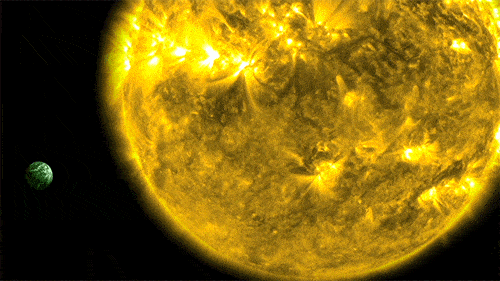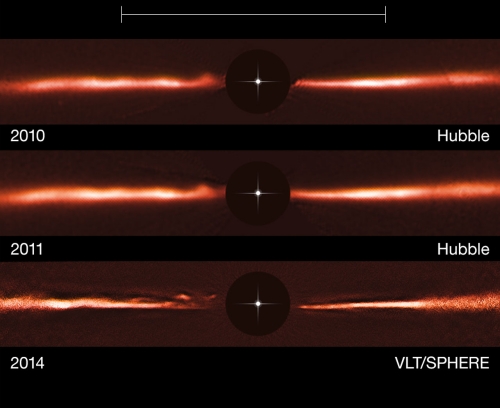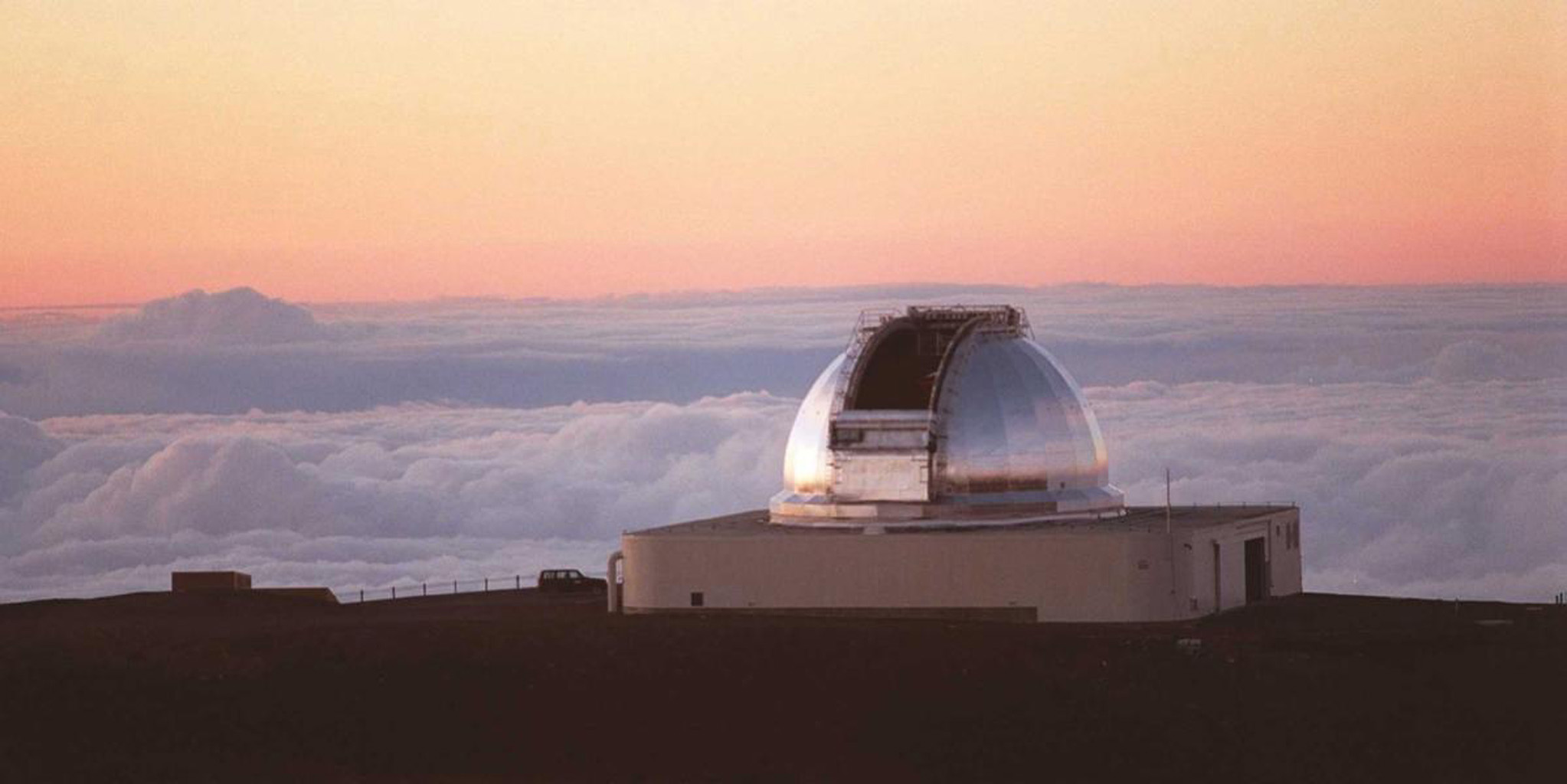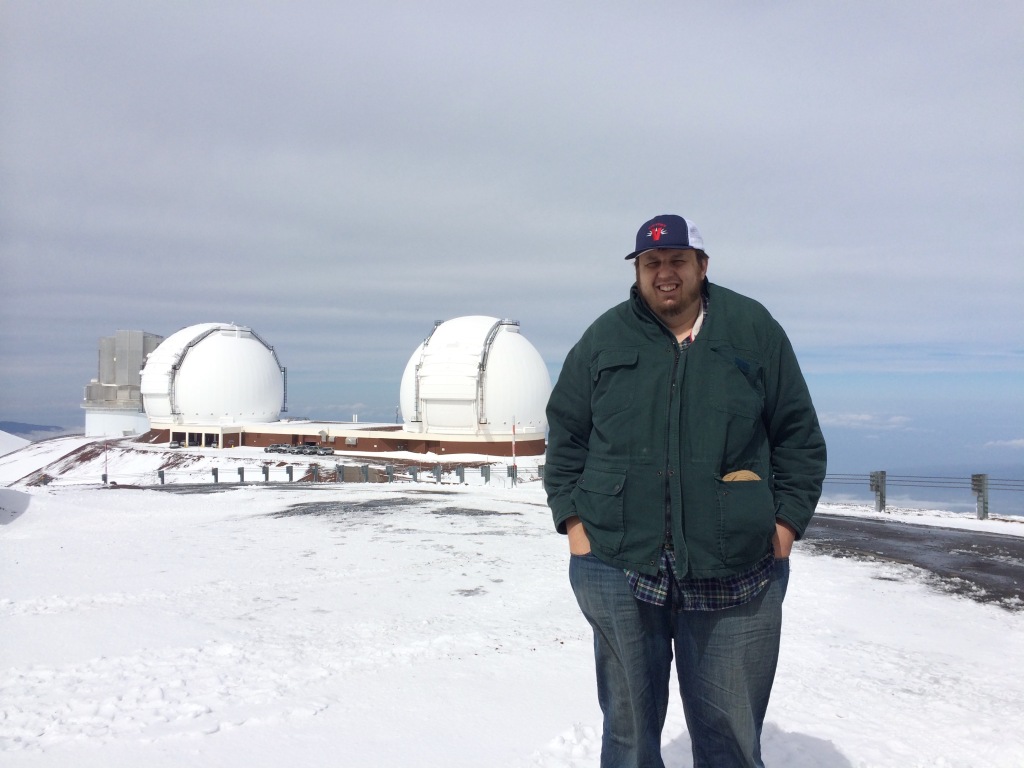AU Mic b: A New Exoplanet in Orbit Around a Remarkable Nearby Star
By Dr Jonathan Gagné
I’m a research advisor at the Planétarium Rio Tinto Alcan of Espace pour la Vie, and I’ll keep you updated with some of our original research here. In this post, I will tell you about the recent
discovery of an exoplanet named AU Mic b. This discovery comes from a
long collaboration with Dr. Peter Plavchan, associate professor at George Mason University,
led since 2010. I joined Plavchan’s team in 2014, and helped them
analyze the data that led to the discovery of this new exoplanet.
This blog post is also available in French here.
 |
| An illustration of AU Mic b, a new Neptune-sized exoplanet. Credit: NASA’s Goddard Space Flight Center/Chris Smith, USRA |
 |
| An illustration of the star AU Mic and its debris disk. Credit: NASA’s Goddard Space Flight Center/Chris Smith, USRA |
AU Mic is a young star, aged only about 24 million years, compared to our Sun's 4.6 billion years. We know AU Mic's age because it is part of the "β Pictoris moving group" a giant "stream" of stars that move together in space, and were born from the same molecular cloud. I talk more about these stellar groups in my first blog post—I spend a lot of my time studying them!
A
visualization of all known stars in the β Pictoris moving group,
compared with the position of the Sun, on which the green circles are
centered. The green circles have radii between 10 and 100 light years.
After approaching the regroupment of stars and moving around it, I
stopped the camera and turned on time to view where the stars are moving
towards in the upcoming few million years. AU Mic is part of this group
of stars, born together but not bound to each other gravitationally. A
higher-resolution version of this video is available here.
AU Mic is smaller than the Sun, with about 75% of its size, and half of its mass. We sometimes call such small stars red dwarfs, because they have a cooler temperature, and that gives them a redder color. They are also sometimes called M dwarfs or M stars in technical jargon, and they are popular stars for the search of exoplanets, for a few reasons.
First, they are very common. The physics inherent to the process of stellar formation causes about half of all stars to be born with masses smaller than half that of the Sun (i.e. M dwarfs). The fact that small stars are ubiquitous means that we can hope to find a larger number of exoplanets in total if we consider them in our searches.
Second, the fact that these stars are smaller, less massive, and dimmer makes them great for the detection of exoplanets. The transit method, whereby we wait for a planet to pass in front its star and make it dimmer, gets us a better sensitivity to small planets when the star is physically smaller. This is true because it is the ratio between the size of the planet and its parent star that dictates how much dimmer the star becomes during a transit event.
This transit method is represented in the video below, where we see the brightness changes caused by planets of different sizes. When we use this method to detect exoplanets, we don't actually see the surface of the star, because it is too far away from us: all that we see is a tiny point of light, which brightness goes down slightly during the transit.
 |
| Representation of an exoplanet transit. Larger planets, or smaller stars, will cause a more easily detected change in brightness. Credit: NASA's Goddard Space Flight Center |
The radial velocity method is what allowed us to discover the first exoplanets around “normal” stars (some exoplanet candidates were found around pulsars a bit before that). Paul Butler, my office neighbor and fellow coffee nerd during my first postdoc at Carnegie Institution for Science in Washington, D.C., is one of the pioneers of the radial velocity method. He likes to recount how his team used a device called an iodine gas cell at the telescope to calibrate their instrument while searching for exoplanets back in the 1990s, and how they were wary that breaking the gas cell would be extremely dangerous.
An illustration of the radial velocity method to detect exoplanets. Credit: NASA, “5 Ways to Find a Planet”
Once again, smaller stars are good for exoplanet detection with the radial velocity method. The intensity of the star's wobble, and therefore the color shift of its light, depends on the ratio between the mass of the planet and that of its star. Therefore, using the same instruments and telescope, we will be able to detect planets of a smaller mass around stars of a smaller mass.
There is, however, one problem that muddies the benefits of exoplanet detection around small stars: small stars are often "hyperactive", which means that they often flare, have lots of stellar spots, and magnetic storms that cause large and random flashes of visible light, UV and X-ray at their surface. This really complicates the detection of exoplanets, because these random events "pollute" the signal of potential exoplanets, and make our data a lot noisier.
The younger stars are even worse in this regard: for reasons we will not get into this time, young stars tend to rotate faster, and that causes them to have stronger magnetic fields. Magnetic fields are what drive stellar spots, mass ejections and violent storms at their surface, so younger stars with stronger magnetic fields will be even more active. AU Mic is one of the worst possible case scenarios in this regard: it is both small and young. Peter Plavchan likes to call it "Speedy Mic" for this reason, because it is a particularly unstable star that likes to flare a lot.
A visualization of what the star AU Mic A might look like with its large clusters of stellar spots and magnetic storms causing bright flashes in visible light, as well as UV and X-ray. Credit: NASA’s Goddard Space Flight Center/Chris Smith, USRA
AU Mic is also really cool (and problematic) for yet another reason: it has a massive disk of debris around it. These debris are the result of planetary embryos, also called protoplanets, smashing into each other and getting blown to smithereens. This disk was discovered in 2005, and has been studied extensively since then. Researchers even found that clumps are moving away from the AU Mic at about 40,000 kilometers per hour in its debris disk! It is still unclear to this day what causes this.
 |
| Hubble and VLT images of the AU Mic disk. These images show the debris disk at distances up to about 60 astronomical units from the star (one astronomical unit is the Sun-Earth distance), and how its structure changes over time. Credits: NASA, ESA, ESO, and A. Boccaletti (Paris Observatory) |
 |
| An image of the inner debris disk of AU Mic taken by ALMA. This image is zoomed in a lot more compared to the previous ones obtained with Hubble and VLT/SPHERE. Credit: Joint ALMA Observatory, ESO, AUI/NRAO, NAOJ, and Cail Daley (Van Vleck Observatory) |
Now, this is a really cool star (in all senses of the word), but it is very hard to search for exoplanets around it because it is super active. We needed something to get past these problems of stellar activity if we hoped to open up the study of exoplanets around small stars in general with the radial velocity and transit methods. One strategy to do this is to stick with the radial velocity method, but look at the star's infrared light rather than its visible light. The signature of stellar activity does not impact infrared light as much as visible light, and the signature of an exoplanet is still apparent in the infrared. However, infrared detectors are a younger technology, making them a lot more expensive and less precise. It is also a lot harder to get a good calibration for these instruments, and this is required to precisely measure a star's color shift as it wobbles around.
This is where Peter Plavchan and his team come in: since about 2010, Peter started collaborating with NASA's Jet Propulsion Laboratory to develop such calibration devices. They built a device called a methane isotopologue gas cell, analogous to the iodine gas cell Paul Butler used, except that it is designed for infrared light (and it is also way less dangerous, thankfully). Peter's team also worked on developing a device even more precise, but way more expensive, called a near-infrared laser comb. |
| The methane gas cell we used at the Infrared Telescope Facility to calibrate our measurements. The gas cell itself is the transparent cylinder at the center of the photo; it is attached in front of our camera, and will therefore sit between the telescope and the camera. The light we receive from a star will pass through this transparent device, and get imprinted with the unique signature of the methane molecules contained in the gas cell, before making its way to the camera. These molecular fingerprints will serve as a calibration for our scientific measurements. |
As soon as Peter got his hands on his methane isotopologue gas cell, he placed it on an instrument called CSHELL at the Infrared Telescope Facility (IRTF) in Hawaii. He began observing some stars near the Earth with his team, focusing on those which exoplanets were inaccessible to visible-light instruments: small stars, and in particular young ones. As you can imagine, AU Mic was one of the first stars they pointed the telescope at, back in 2010.
 |
| The IRTF telescope, on the Mauna Kea volcano in Hawaii. The observatory literally sits above the clouds. Credit: NASA, JPL |
Apart from helping with the telescope observing, I spent much of my time in Pasadena writing computer codes to transform the raw data the CSHELL camera gave us into measurements we can use and interpret. This may sound surprising when you are used to taking pictures with a commercial camera, but images that come out from scientific cameras require a lot of work before we can hope to obtain a final product. In this particular case, the final product we obtain for every star, and every night spent at the telescope, is a single measurement of how fast the star is moving towards us, or away from us (this is what a radial velocity measurement is). Pasadena is also where I discovered Copa Vida's single-origin espresso shots, which began a whole other journey for me!


Peter Plavchan and I, staring at the Sun with the Keck telescopes in the background. This is the view we had when arriving at the IRTF telescope, located behind the camera. Photos by myself and Peter Plavchan
 |
| Shoveling snow was part of the job as we got caught in a snowstorm during one of our 2017 observing runs at the IRTF telescope (seen here in the photo). Photo by Peter Plavchan |
Once we started gathering iSHELL data, it did not take long before Peter Plavchan noticed something weird about AU Mic. He emailed us in fall 2016 to tell us that he thought there might well be first signs of an exoplanet hiding in our data. However, this would have been a dangerous claim to make publicly, especially given that we were venturing in an unexplored territory with applying the infrared radial velocity method to an exceptionally active star. We needed to be absolutely certain that what we were seeing was an exoplanet, so we needed to keep observing it as often as possible.
 |
| A view of the IRTF telescope's primary mirror from inside the dome. Photo by Peter Plavchan |
The transit signal also indicated that AU Mic b orbits its star every 8.5 days. This is an extremely short orbital period! Imagine if the Earth orbited around the Sun that fast: our year would only last 8.5 days. AU Mic b orbits so fast because it is very close to its star, at 0.07 astronomical units, only 7% of the distance between the Earth and the Sun. The radial velocity data we have in hand also indicates that the mass of AU Mic b is smaller than 3.4 times that of Neptune, and TESS data indicates that its size is almost exactly the same as Neptune. Interestingly, TESS data also shows hints of a possible second planet, at 0.13 astronomical units from the star (almost twice as far from its star as AU Mic b), and twice the size of the Earth. However, we will need more data to be sure, especially when working with a star as noisy and unstable as AU Mic.
This is a really cool discovery, not only because it opens the door to more research for exoplanets around young and small stars. The fact that AU Mic is so young means that we are catching the exoplanet AU Mic b in the first moments after it formed. Some researchers think it may have formed a bit further from its star, at about 10 astronomical units, and then migrated inwards. If that is true, it means that it must have migrated fast, because it already landed as its current location when the star is still only about 24 million years old.
Another reason why this discovery is so cool is that AU Mic is really not that far from us: it is only 32 light years away, what we can safely call our galactic backyard. It is indeed one of the closest stars to us in the whole β Pictoris moving group, as can be seen below:
A visualization of all known stars in the β Pictoris moving group, compared with the position of the Sun, on which the green circles are centered. The green circles have radii between 10 and 100 light years. The camera moves around the β Pictoris moving group, and then I gradually increase the brightness of AU Mic to show where it is located: it is one of the β Pictoris moving group stars nearest to us. A higher-resolution version of this video is available here.
This system is so close to us that AU Mic b is one of the closest exoplanets we currently know! In fact, only 37 of the currently confirmed 4,171 planetary systems compiled on the NASA exoplanet archive are closer to us than AU Mic. But yet again, an image is worth a thousand words, and a video is worth a thousand images:
A visualization of the AU Mic system location compared with the position of the Sun, on which the green circles are centered. The green circles have radii between 10 and 100 light years. After a few seconds I turn on the locations of all 2,979 currently known and confirmed exoplanet systems for which we know the precise distance from the Sun (required to determine their 3D position). Notice how some of the exoplanet systems form square patterns in the sky when the camera is close to the Sun, at the seventh second of the video near the center of the frame: those are the shapes of the Kepler detectors, back when it always stared in the same direction during its main mission. When we move away from the Sun, we can better see how known exoplanets are located either relatively close to the Sun, or in the direction where Kepler stared. A higher-resolution version of this video is available here.
Now the science does not end here: Peter got busy teaming up with scientists around the world before publishing his Nature paper, to begin further investigations of this new planetary system. This led to five(!) additional scientific papers, all timed to also become public on June 24th. Four of these teams measured the obliquity of AU Mic b—the tilt between its rotation axis and the axis of its orbital motion, see this video for more explanations—and they all found that the planet's spin axis is aligned with its orbital axis. This is evidence that it indeed formed from AU Mic's protoplanetary disk, and likely did not suffer a cataclysmic collision with other planetary embryos.
There are still many unknowns about how planets form, so discovering young systems like AU Mic b is important to challenge our expectations and refine our understanding of this process. Each one of these discoveries provides us with a "photography" of what a given system may look like at a given age. Remember that one million years is very short at the astrophysical scale, so we cannot wait to see how AU Mic b will evolve, and we need to instead find another similar but slightly older system if we hope to constrain exactly what will happen next in the life of AU Mic b.
One of the five teams mentioned above, featuring other members of the Institute for Research on Exoplanets at Université de Montréal here in Québec, also measured the strength of the magnetic field of the star AU Mic, and how it varies with time. They used this to better understand how the star's activity affected the radial velocity measurements.
Another scientific team tried to measure the atmospheric composition of AU Mic b with a method called transit spectroscopy, but the star was so active that it prevented them from being able to measure a useful signal. NASA's upcoming James Webb Space Telescope (JWST) will probably be able to do this successfully.
Finally, another one of the scientific teams built computer simulations to better understand how AU Mic's stellar wind may affect the atmosphere of its exoplanet. They found that stronger winds will tend to compress the planet's atmosphere, and make it harder to measure its composition with our instruments. They also made predictions about what the transit would look like at a specific wavelength of light (i.e. a color of light). Measuring AU Mic b's planetary transit with an instrument designed to see this specific color only will shed more light on how strong the stellar winds of AU Mic are, and whether AU Mic b's atmosphere is getting eroded or not by the star's violent UV and X-ray emissions.
NASA got so excited about this discovery that, on top of all the nice visualizations they made for AU Mic and its planet, they also created this awesome poster:
A promotional poster of the exoplanet AU Mic b. Credit: NASA-JPL/Caltech
I would like to thank Peter Plavchan, Marc Jobin, André Grandchamps and Marie-Eve Naud for their comments.
